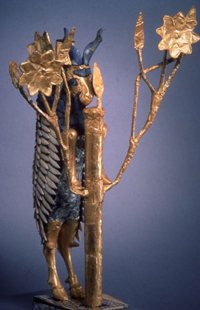
In the 1920's, the Royal Cemetery of Ur excavations became one of the great technical achievements of Middle Eastern archaeology, and now represent one of the most spectacular discoveries in ancient Mesopotamia. Deep within the site lay the tombs of the mid-3rd millennium B.C. kings and queens of the city of Ur, famed in the Bible as the home of Biblical patriarch, Abraham.
The tombs date to the period known as Early Dynastic IIIA (2600-2500 B.C.), a high point in the history of Sumerian culture.
The renowned excavator of the cemetery was British archaeologist Sir Leonard Woolley, who directed a joint expedition of the University of Pennsylvania Museum and the British Museum. The team uncovered some 1800 burials, 16 of which Woolley classified as royal based on their distinctive form, their wealth, and the fact that they contained the burials of household servants, male and female, along with clearly high-ranking personages.
As provided by Iraq's first Antiquities Law, established in 1922, the artifacts were divided between the excavators and the host country. They are currently housed in the British Museum, the University of Pennsylvania Museum, and the Iraq Museum in Baghdad. Some of the more striking and important artifacts from the tombs, now in the University Museum, include a large wooden lyre with a gold and lapis lazuli bull's head; a silver-covered, boat-shaped lyre with a statuette of a rampant stag; and the world-renowned "Ram-in-the-Thicket," a statuette of a goat standing and nibbling the leaves of a tree or bush.
In 2016, Penn archaeologists again returned to Ur, under the direction of AAMW alum Dr. Brad Hafford, (initially alongside archaeologists at SUNY Stony Brook), to investigate a series of houses. Beginning in 2024, the focus of the project switched to conservation and community engagement under the joint direction of Dr. Lauren Ristvet and Dr. Salam al-Kuntar (Rutgers).
